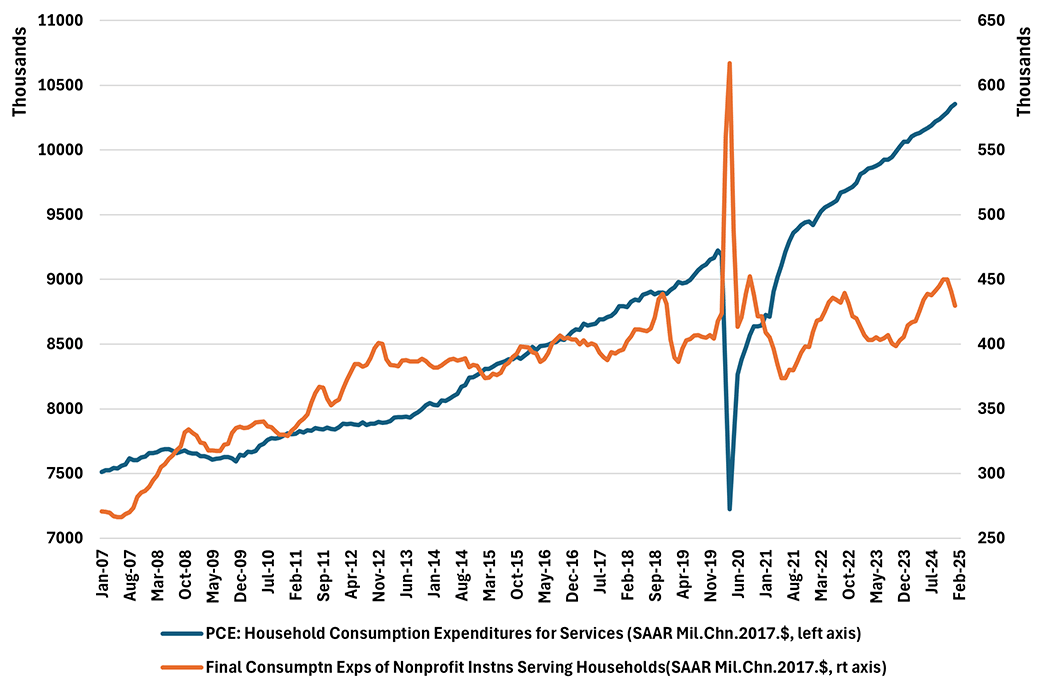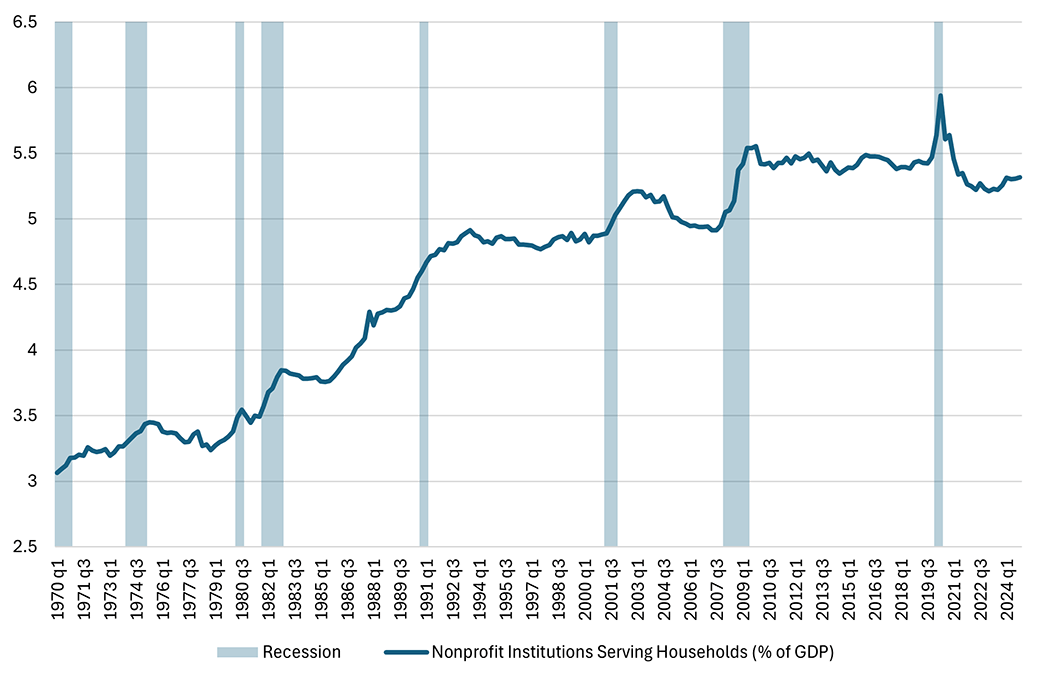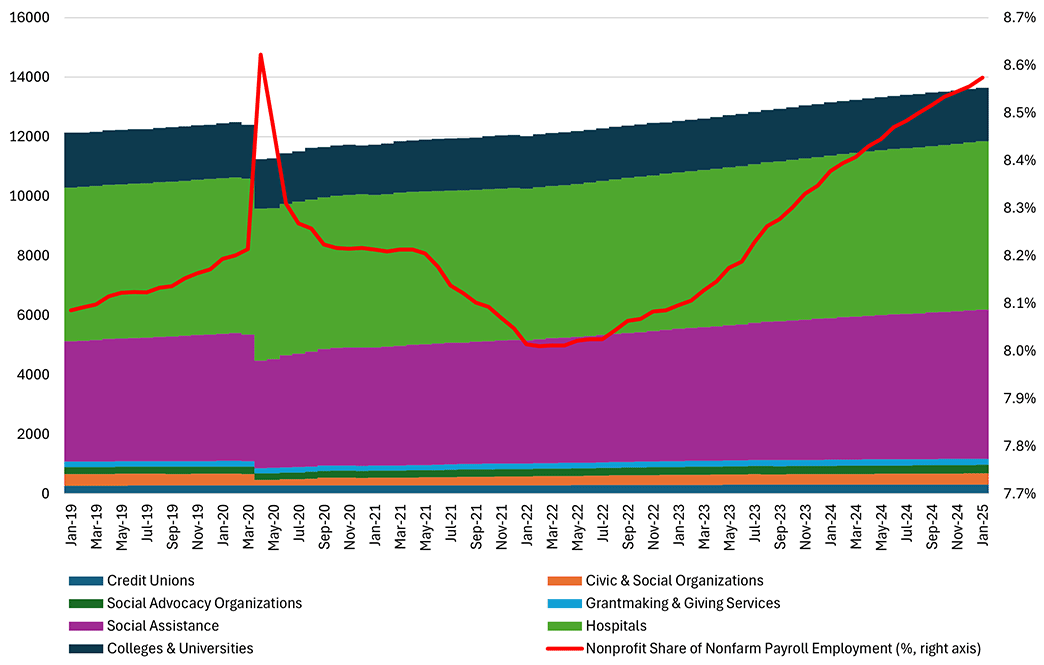How Big Is the Nonprofit Sector?
January's personal income and outlays report revealed that services spending slowed to a 1.0 percent annualized monthly growth rate compared to a 3.4 percent annualized growth rate in December. However, the report's details showed a divergence between household consumption expenditures for services and net spending by nonprofit institutions serving households: The former grew at a 2.6 percent annualized rate, while the latter fell at a 26.6 percent annualized rate.
Figure 1 illustrates the divergence in the latest data between services spending by households and spending by nonprofit institutions serving households. A decrease in spending by the nonprofit sector could affect a broad range of geographies and activities. A 2021 report by the Urban Institute shows that the distribution of nonprofits across the U.S. is similar to that of the U.S. population, with organizations providing a vast array of services such as arts and culture, health, education, and research. The extent to which a slowdown in nonprofit demand impacts the broader economy depends on the relative size of the nonprofit sector in the economy. This is the topic of this week's Macro Minute post.
While Figure 1 suggests that nonprofit expenditures are small relative to households' consumption of services (accounting for less than 5 percent of household services consumption in January 2025), other measures indicate a larger role for the nonprofit sector in economic activity. For example, the Bureau of Economic Analysis decomposes GDP into contributions attributable to the government, businesses, households and nonprofit institutions serving households. The contribution of nonprofits is measured by the compensation of employees of nonprofit institutions, the rental value of nonresidential assets owned and used by nonprofit institutions, and the rental income obtained from tenant-occupied housing owned by nonprofit institutions.
As shown in Figure 2, the contribution of nonprofits to GDP as of the fourth quarter of 2024 was 5.3 percent, just under the prepandemic share of approximately 5.5 percent. The contribution of nonprofits to overall GDP rose from 1970 through the end of the 2007-09 Great Recession but has generally stabilized under 5.5 percent since then, with the exception of a brief spike during the pandemic recession in 2020.
Nonprofits account for an even larger share of the labor market. While the monthly Employment Situation Report does not break out household or payroll employment into for-profit and nonprofit sectors of the economy, it is possible to obtain an estimate of the size of the nonprofit sector in overall nonfarm payroll employment by looking at industries with a significant nonprofit presence. This includes universities, hospitals, civic and social organizations, and social advocacy organizations.
Figure 3 shows that these industries employed 13.6 million people in January 2025, accounting for 8.6 percent of total nonfarm payroll employment. A caveat is that this is only a rough estimate of the size of the nonprofit sector. For example, it also includes employment at for-profit hospitals and universities and omits nonprofit institutions in other industries.
However, alternative (though lagging) data from the Bureau of Labor Statistics' Quarterly Census of Employment and Wages and Business Employment Dynamics programs can be used to validate this estimate. In 2024, the BLS reported that nonprofits accounted for 12.8 million jobs — or 9.9 percent of private-sector employment — in 2022. In contrast, Figure 3 has a lower estimate of 12.5 million in December 2022, corresponding to 9.5 percent of private-sector employment and 8.1 percent of overall nonfarm payroll employment. Thus, it is possible that the 8.6 percent estimate in January 2025 is also an underestimate of the employment share of the nonprofit sector.
These calculations show that, despite making up a modest share of personal consumption expenditures, nonprofits play a significant role in economic activity and employment. To the extent that January's spending slowdown stems from challenges to the nonprofit sector, these challenges may also leave an imprint in upcoming GDP and employment reports in 2025.
Views expressed in this article are those of the author and not necessarily those of the Federal Reserve Bank of Richmond or the Federal Reserve System.




